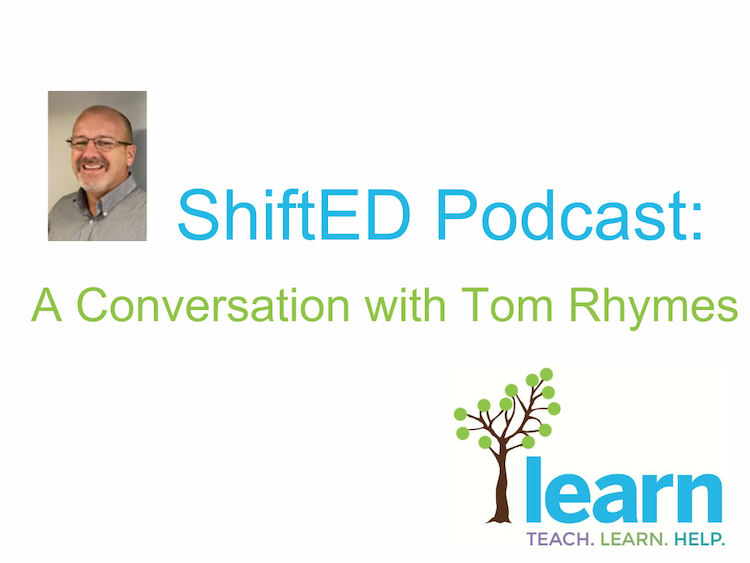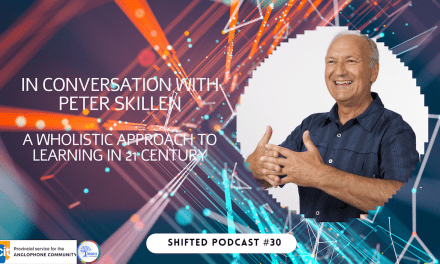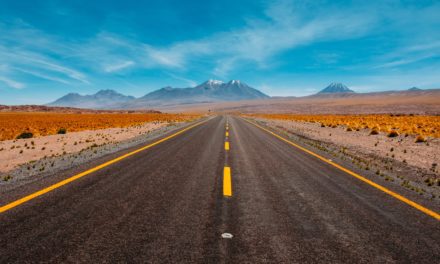Today, I had the chance of catching up with the Assistant Director General of the Lester B. Pearson School Board, Tom Rhymes, regarding how his board has been adapting to our new “normal.” His wonderful reflections are both inspiring and reassuring. Our future educational system is chock-full of creativity and humanity, as Tom eloquently puts it, this is “Education’s finest moment.”
Transcript
edited for readability
Chris Colley (LEARN): Welcome to today’s ShiftED Podcast. Today we are talking with Assistant DG (Director General) from Lester B. Pearson school board: Tom Rhymes. He’s taking some time out of his busy schedule to talk with us today about the shift that’s going on amidst our pandemic.
So, thanks for talking with us today Tom. Let’s start off by rewinding the clocks a little bit and think back to that famous March 2020. Friday the 13th, I believe it was…to be exact. What happened? What went down over at Lester B? How did everything start to unfold?
Tom Rhymes (Assistant Director General, LBPSB): Well, Chris, I’m going to start by saying that that seems like such a long time ago.
Chris: Doesn’t it?
Tom: And I don’t think the surreal nature of all of this has ever gone away. It was a surreal feeling and I can remember it clear as a bell here in the Board office. Not really knowing what the heck was going to happen on that fateful Friday the 13th – easy to remember and who would’ve called that? That it would’ve been Friday the 13th when we – we quote-unquote “closed down for a couple of weeks”. It had, I would say, a beyond-the-Twilight-Zone feel to it.
To say we’re shutting down because of what honestly felt like a movie or a TV show or something. And then, feeling our way through that… Both professionally and personally and I think that’s the thing that we perhaps haven’t spoken about is that this is a journey that we, as a system, have been undergoing and have been living professionally. But, we’re simultaneously living that personally. So there’s not even any sense of walking away from the professional challenge, because that same challenge is presenting itself in our personal lives. And perhaps that’s what’s made it so extraordinary – is there has been no – I don’t know if using the word ‘escape’ – but there has been no escape from this. It has been pervasive in everybody’s life. We’ve been trying to manage this new reality professionally, while we’re also trying to manage it personally. And that I think is perhaps the extraordinary thing.
Chris: As we reflect on what happened in the end of our 2019-2020 school year, there was lots of reflection that went on and lots of looking to the future and how were we gonna survive this pandemic in schools. How are schools gonna adapt to the changing landscape? So, if we look back at that Tom, what were some of the key moments or the big takeaways that helped you get ready for school starting up in September or, Aug-Sep 2020?
Tom: It was difficult managing it and I think it’s easy for everybody to become critical of how all of this was managed. But, we also have to recognize that to call this an extraordinary circumstances is to understate it. So, I won’t dwell on the pivots and the change in policy and directions – that is what it is. I think there are two things that I took away from the Spring that really impacted how we approach the startup in August.
The first one is: I think I would say Chris, the revelation when, for better or for worse, we had the call to finally open our schools for what were called pedagogical camps – des camps pédagogiques – in late May and early June. It sent a lot of people for a real spin because we’ve been through the ringer – incredibly stressful, trying to kind of, make it to the finish line and suddenly we had this expectation dropped in our laps that we were going to open for students.
And I can get emotional talking about this because to me, it really speaks to what motivates our educators and what drives the people who are working in our system. When those schools, primarily the elementary schools, and some of our high schools were able to get them going but … the heartfelt, true, honest, raw emotion of the people working in the system. When they saw those kids. It’s difficult for me to talk about it. It was very moving to have our people say, “oh my goodness’, some of our kids are in really rough shape”.
It wasn’t all Netflix and chocolate cake at home for some of them. They needed … they needed to be in school. They needed to be with friends. They needed to be out of the house. And it was – I think it was a revelation to the people working in the system about how much it meant and how much it means for kids to be around their peers. I think that drove a lot of people, in terms of readiness for all this and their readiness for September. They recognized the importance of having kids come to school. Not the learning – I mean, the learning is there and the learning will always be there.
But, taking away that socialization – taking away that peer-to-peer contact and even how important the educators are for the kids. That was a revelation. So, there was a commitment, I think, a real commitment to make it work. There was fear, obviously. There was anxiety – there continues to be anxiety. But, I think people felt a calling – a real need to provide for the kids.
The second thing I would say is, we wanted to keep it as simple as possible. Extras, expectations for extraordinary pedagogy – that stuff would come. Let our objective be to get these kids into the building, to get them in the building safely, to have everybody who’s working with be safe, and be able to provide what they need. Which is a place to be together with their peers and learn and grow and laugh and cry and all of those things that, in many ways, were denied them during the shutdown.
Chris: Let’s talk a little bit about how professional development has changed. The landscape for professional development has shifted where we’re maybe focusing a little less on content and we’re focusing more on, how do we create a relationship through online learning and how do we keep kids engaged in wanting to go forward with learning. Can you talk to us a little bit about how the change in professional development that Lester B. Pearson has been experiencing since the pandemic began?
Tom: Well, I think, it’s a great question because it’s always the struggle of doing your training while you’re doing the job and it incidentally drops in and out of your school year. Sometimes I like to say that this is Education’s finest hour. I have been so struck by how creative educators have been in the face of the challenges that are in front of them. And realizing their capacity to be creative and needing to do things that they’ve never done before, but being able to do them. Being able to look at things that they have normally done in class or activities that were anchors of their program and then figuring out how to tweak them and adjust them, maybe change the direction a little bit but still get the outcome they want. That has been incredible.
Similarly, we’ve invested a lot of time in what I would call “distance pedagogy” – meaning, how do you extend beyond seven fifty-minute Zoom calls or what have you. And the degree to which our educators have been receptive to this has been phenomenal – absolutely phenomenal, because they want to be creative. It sort of goes back to what we were discussing earlier I think, where it’s stripped down, we strip down our lives and we strip down our professional lives to some very basic things in the face of the pandemic. We often think of creativity in very grandiose terms, right? You know…if there’s lots of bells and whistles and it’s flashy…but the degree to which people are being creative by tweaking things that they’ve always done to make them work.
For example, if their students are locked in a bubble for two weeks, there’s an incredible amount of creativity required to have that work, to keep those students engaged, to make things interesting – people finding in themselves that creativity has just been humbling for me. I’ll say it again – I cannot believe what people are doing to make this work. The PD is, in many ways, orienting our educators to see how they can be creative and how they can make minor adjustments in what they have done so that the student experience is still a really positive one.
Chris: We’re left to deal with, what do we do with the students that are unable to come to school? We still have to provide an education, a school routine, a classroom routine. Talk to us a little bit about what you’re offering at Lester B. I believe you have five hundred students online so it must be – it’s almost like a whole other campus that you’ve had to create. Talk to us a little bit about that online school that you’re having to develop kind of on the fly.
Tom: It’s unfolding and it continues to unfold and that, in many ways, we were lucky. We have had a consultant working or, we had a consultant working in kind of a virtual campus sort of setup, for us, for a couple of years prior to the pandemic. We were working on some online option courses and trying to orient and work with some teachers in our high schools that work to look at blended models. Some of what they would do would be online and not having necessarily the need to see students physically six times a week for fifty minutes. Perhaps there could be some online elements.
We were fortunate in that a lot of the groundwork, a lot of the legwork for setting up the training and the structure for the online campus had been done. We had some connections with some groups in New York state and in California that [were] pre-existing partnerships and relationships that helped us with that. What has been difficult is – I think the same thing that’s been difficult for many school boards, at least, in the English side – the volume of students. We have over six hundred students in our online campus, which, basically is like opening a school from scratch on the fly. And constant traffic in and out of that school, because people’s circumstances are changing. Situations that may have existed in August don’t exist anymore, or situations that didn’t exist in August now exist. So, people are in and out of those classes and that movement has been a challenge.
Staffing has also been a challenge. I mean, we didn’t necessarily plan for opening a whole new school and having teachers available to staff the online campus. It has been a challenge trying to find people who are available and willing to take on that challenge. I won’t say that it’s been easy. I won’t say that it’s been impossible. But, it’s been an ongoing work in progress. But there are success stories there. Certainly the feedback that we’re getting from students after some initial sort of challenges to open up.
The feedback from students and parents has been positive – it’s working. And what will be interesting is to see, once we’re out of this “Twilight Zone”, whether there’s traction to maintain, not necessarily an online school per se but, a campus of sorts where there are courses that we can offer from a distance in the name of innovation.
Chris: I guess my final question Tom is, has your vision or the school board’s vision changed about the direction of education or the direction that it’s going on? Thinking about school redesign, having to build a whole new virtual campus, I’m sure there’s a lot of those conversations that are going on about that transformation – how do we do it? Has your vision changed at all of how you used to see schools as opposed to how you’re seeing them now and the direction that they’re going in?
Tom: I’m not sure I would say my vision has changed. As I mention, this is a thread that we’ve been pursuing for a while and certainly there’s lots of professional talk out there about what school could look like. But, what I think has changed for me is, this realization of how far we would have to go to make it happen. People, out of necessity, and I keep going back to that word creative – have become creative in what they’re doing. And educators, teachers, integration aides, support staff, everybody is realizing that they have it in them to do that. They have the capacity to do things a little differently.
I’ll tell you one thing and it’s a small thing but, in traveling around to schools and I think the impetus for this was out of safety, but I also think people are realizing it’s a good thing, the number of teachers who have moved outside with their students. The number of schools I’ll drive by in the middle of the day and see three, four, five classes outside, doing whatever it is they’re doing and that’s a small thing but students are learning in that kind of circumstance. Teachers are realizing that students can learn in that sort of circumstance and they probably always knew it but were looking to kind of give themselves permission to go in that direction. That sort of thing in itself is huge. You don’t need to be at the desk. You don’t need to be in the room. You can be outside and [nurture] very meaningful learning activities.
The idea of blended models – as much as our fifteen-year-olds say or, in your case and in my case as well, or even university aged kids are going, “Oh my gosh, I’m sitting through Zoom session after Zoom session after Zoom session,” and I don’t think our educators are all that keen in sitting in and delivering in Zoom session after Zoom session after Zoom session and they’re discovering things that they can do where they don’t have to do that. Discovering ways of delivering pedagogy or engaging students in more project-based, blended kinds of models which is very engaging for students, very, very engaging for students. Your learning outcomes are enhanced with that and it’s not teacher-directed. It’s student-directed. And I don’t think that’s something that’s going to go out with the bathwater. I think that there are a great number of people who are going to carry those lessons and say, “Y’know – it really changed, fundamentally changed the way I approach my teaching.”
Chris: I want to thank you Tom for this great conversation. It’s a very timely conversation I feel and I think a lot of your words will really help our community starting to understand a little bit about what’s the future holds and how things are going. So, I really want thank you for spending a little bit of time with us. I know your schedule is probably extremely full. So, your time is much appreciated and I really want to thank you with all our hearts for coming in and sharing your experiences with us.
Tom: Absolute pleasure Chris and like I said, I think this is Education’s finest moment. They are keeping it together.





